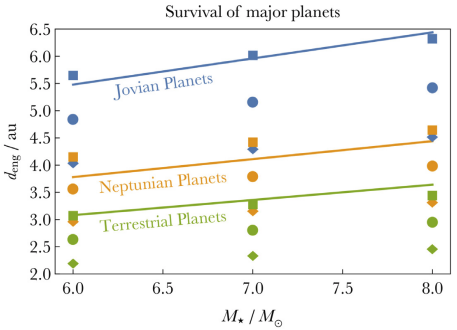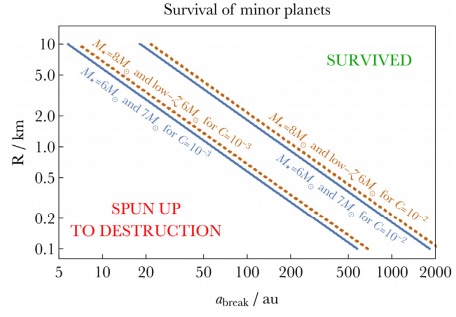Constraining planet formation around 6-8 M☉ stars
- 1Centre for Exoplanets and Habitability, University of Warwick, Coventry CV4 7AL, UK
- 2Department of Physics, University of Warwick, Coventry CV4 7AL, UK
- 3Department of Astronomy, Boston University, 725 Commonwealth Ave., Boston, MA 02215, USA
Identifying planets around O-type and B-type stars is inherently difficult; the most massive known planet host has a mass of only about 3 M⊙ . However, planetary systems which survive the transformation of their host stars into white dwarfs can be detected via photospheric trace metals, circumstellar dusty and gaseous discs, and transits of planetary debris crossing our line of sight.
These signatures offer the potential to explore planet formation efficiency and chemical composition for host stars with masses up to the core-collapse boundary at ≈ 8 M⊙ , a mass regime rarely investigated in planet formation theory. Here, we establish limits on where both major and minor planets must reside around ≈ 6–8 M⊙ stars in order to survive into the white dwarf phase. For this mass range, we find that intact terrestrial or giant planets need to leave the main sequence beyond approximate minimum star–planet separations of, respectively, about 3 and 6 au, as shown here:

Further, in these systems, rubble pile minor planets of radii 10, 1.0, and 0.1 km would have been shorn apart by giant branch radiative YORP spin-up if they formed and remained within, respectively, tens, hundreds, and thousands of au, as shown here:

Overall, we find that planet formation around 6 M⊙-8 M⊙ stars may be feasible, and hence we encourage dedicated planet formation investigations for these systems.
How to cite: Veras, D., Tremblay, P.-E., Hermes, J., McDonald, C., Kennedy, G., Meru, F., and Gänsicke, B.: Constraining planet formation around 6-8 M☉ stars, Europlanet Science Congress 2020, online, 21 September–9 Oct 2020, EPSC2020-412, https://doi.org/10.5194/epsc2020-412, 2020

